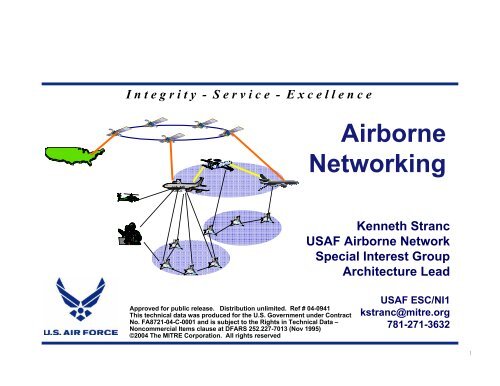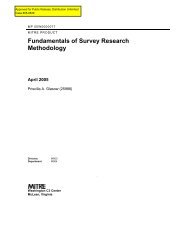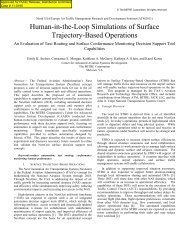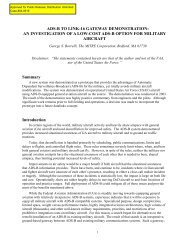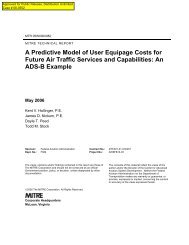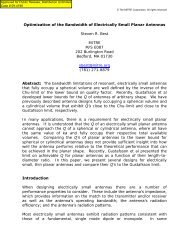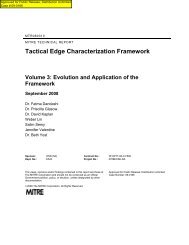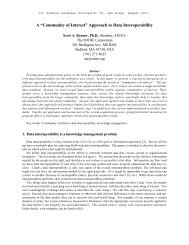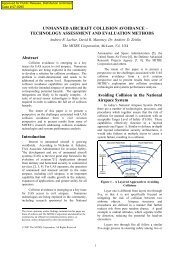Airborne Networking - Mitre
Airborne Networking - Mitre
Airborne Networking - Mitre
Create successful ePaper yourself
Turn your PDF publications into a flip-book with our unique Google optimized e-Paper software.
I n t e g r i t y - S e r v i c e - E x c e l l e n c e<br />
UNITED STATES ARMY<br />
U.S. AIR<br />
FORCE<br />
Approved for public release. Distribution unlimited. Ref # 04-0941<br />
This technical data was produced for the U.S. Government under Contract<br />
No. FA8721-04-C-0001 and is subject to the Rights in Technical Data –<br />
Noncommercial Items clause at DFARS 252.227-7013 (Nov 1995)<br />
©2004 The MITRE Corporation. All rights reserved<br />
<strong>Airborne</strong><br />
<strong>Networking</strong><br />
Kenneth Stranc<br />
USAF <strong>Airborne</strong> Network<br />
Special Interest Group<br />
Architecture Lead<br />
USAF ESC/NI1<br />
kstranc@mitre.org<br />
781-271-3632<br />
1
� Describe the context in which an <strong>Airborne</strong><br />
Network will operate<br />
• Operational requirements span a huge range<br />
Purpose<br />
• Technical communications challenges are daunting<br />
� Initiate a dialog on the impact of using XML in an<br />
<strong>Airborne</strong> Network<br />
• Network performance and transition issues are likely to<br />
constrain use of XML in the air<br />
2
�� <strong>Airborne</strong> Operations and Network Traffic<br />
Characteristics<br />
�� <strong>Airborne</strong> Network Architecture<br />
Overview<br />
�� Technical Challenges and Opportunities in the<br />
<strong>Airborne</strong> Domain<br />
�� Use of XML in the <strong>Airborne</strong> Network<br />
�� Summary<br />
3
UNITED STATES ARMY<br />
Command & Control (C2)<br />
Constellation Configuration<br />
• Global Strike Task Force in<br />
Persistence Phase<br />
• Theater Mission<br />
• Line of Sight of Many<br />
Nodes<br />
<strong>Airborne</strong> Operations and Network Traffic Characteristics<br />
<strong>Airborne</strong> Mission Profiles<br />
En-Route<br />
Configuration<br />
• Airlift En-Route to<br />
Theater<br />
• B-2 En-Route to<br />
Theater<br />
• Global Mission<br />
• Beyond Line of Sight<br />
of Surface Nodes<br />
Strike Package<br />
Configuration<br />
• Global Strike Task<br />
Force in Kick-<br />
Down-Door Phase<br />
• Fighters, Attack,<br />
Bombers, Munitions<br />
• Beyond Line of<br />
Sight of C2 Assets<br />
4
Traffic Type<br />
Low-latency<br />
Line of Sight<br />
Command &<br />
Control<br />
Situational<br />
Awareness<br />
Tactical<br />
Video, Voice,<br />
Imagery<br />
Non-timecritical<br />
Information Unit<br />
Size or Type<br />
Very compact bitoriented<br />
messages, e.g.,<br />
65 Kbits<br />
Continuous or<br />
interrupted stream<br />
Files, messages,<br />
<strong>Airborne</strong> Operations and Network Traffic Characteristics<br />
Representative AN Traffic<br />
Delivery<br />
Latency<br />
95%<br />
Range of<br />
Transmission<br />
<strong>Airborne</strong> Operations and Network Traffic Characteristics<br />
<strong>Airborne</strong> Traffic Profile is Changing<br />
Now – Sensor-to-display<br />
• Fixed target locations<br />
• Moving target tracks<br />
• Air and surface situational awareness data<br />
• Target identification<br />
• Radar data<br />
• Voice<br />
Future – Machine-to-machine<br />
• Moving target updates to en-route weapon<br />
• Pre-strike imagery returned from a weapon<br />
• Sensor fusion data<br />
• C2 collaboration data<br />
• More ISR products<br />
• Joint Unmanned Combat Aerial Vehicle<br />
(JUCAV) control<br />
• Reachback queries for specific information<br />
6
<strong>Airborne</strong> Operations and Network Traffic Characteristics<br />
<strong>Airborne</strong> Network Platform Types<br />
Command and Control<br />
Intelligence, Surveillance, Reconnaissance<br />
Logistics (Tankers, Airlift)<br />
Strategic (Bombers)<br />
Tactical Edge (Fighters, Attack)<br />
Weapons (Dispensers, Munitions)<br />
7
Today<br />
U.S. AIR<br />
FORCE<br />
U.S. AIR<br />
FORCE<br />
<strong>Airborne</strong> Operations and Network Traffic Characteristics<br />
<strong>Airborne</strong> Connectivity is Changing<br />
Space Backbone<br />
U.S. AIR<br />
FORCE<br />
Air Backbone<br />
Tactical Data Links<br />
Wideband air-air links<br />
Ad-hoc networks using Joint Tactical<br />
Radio System (JTRS) <strong>Networking</strong> Services<br />
Space Backbone<br />
U.S. AIR<br />
FORCE<br />
Air Backbone<br />
8
� <strong>Airborne</strong> Operations and Network Traffic<br />
Characteristics<br />
� <strong>Airborne</strong> Network Architecture<br />
Overview<br />
� Technical Challenges and Opportunities in the<br />
<strong>Airborne</strong> Domain<br />
� Use of XML in the <strong>Airborne</strong> Network<br />
� Summary<br />
9
<strong>Airborne</strong> Network Architecture<br />
Broad range of technical requirements<br />
� Network structure<br />
• Self-forming, self-organizing, self-healing<br />
• Fast formation and organization - join, leave, reorganize<br />
quickly<br />
� Information Transport Performance<br />
• Very short transport latency to normal latencies to best effort<br />
• Assured delivery of information – delivered correctly within<br />
expected time period<br />
� Special case - receive-only mode platforms<br />
� Intra-network range<br />
• Line-of-sight as well as beyond-line-of-sight intra-networking<br />
� Integration with the Global Information Grid (GIG)<br />
• AN will provide airborne connectivity for USAF’s<br />
ConstellationNet, Army’s LandWarNet, and Navy’s ForceNet<br />
• Requests for information can spawn reachback connection to<br />
other parts of the GIG<br />
• GIG mandates (i.e., IP, XML) apply to the AN<br />
10
Space<br />
Backbone<br />
<strong>Airborne</strong><br />
Backbone<br />
Emerging<br />
Tactical<br />
Networks<br />
<strong>Airborne</strong> Network Architecture<br />
<strong>Airborne</strong> Objective Architecture<br />
Mission<br />
Satellites<br />
Comm Transformational<br />
Satellites<br />
Comm Program<br />
<strong>Airborne</strong> Network Domain<br />
Tactical Network<br />
Edge<br />
TDLs<br />
ISR Network<br />
Edge<br />
Emerging<br />
Sensor<br />
Networks<br />
CDLs<br />
Terrestrial<br />
Networks<br />
Fiber<br />
grid<br />
11
“WAN” service delivery point to platform<br />
Modern<br />
infrastructure<br />
<strong>Airborne</strong> Platform<br />
Network-capable<br />
Hosts<br />
Platform<br />
LAN<br />
Legacy (non-IP)<br />
Host<br />
Legacy (non-IP)<br />
Host<br />
<strong>Airborne</strong> Network Architecture<br />
Implementing the AN on platforms<br />
Router,<br />
Firewall,<br />
AN<br />
Crypto,<br />
Equipment<br />
etc<br />
Legacy<br />
infrastructure<br />
<strong>Airborne</strong><br />
Network<br />
Emerging<br />
Radio Terminals<br />
Legacy Tactical<br />
Data Link Terminals<br />
Legacy CDL<br />
Terminals<br />
Connection point for platform radios<br />
Legacy<br />
TDL Net<br />
Legacy<br />
CDL Net<br />
Suite of mission-selectable functions:<br />
1. Platform Host Interface to the AN<br />
2. Off-board Routing<br />
3. Transit Routing<br />
4. Legacy Data Link Interface to the AN<br />
5. Security<br />
6. Network Management<br />
7. Link Management<br />
8. Network Services<br />
12
� <strong>Airborne</strong> Operations and Network Traffic<br />
Characteristics<br />
� <strong>Airborne</strong> Network Architecture<br />
Overview<br />
� Technical Challenges and Opportunities in the<br />
<strong>Airborne</strong> Domain<br />
� Use of XML in the <strong>Airborne</strong> Network<br />
� Summary<br />
13
Technical Challenges and Opportunities in the <strong>Airborne</strong> Domain<br />
Considerations in Architecting the AN<br />
� Expanded range of networking requirements<br />
• Concurrent line-of-sight and internetwork operational modes<br />
• Very low latency to best-effort latency<br />
• Assured delivery to best-effort delivery<br />
� Cannot assume any connectivity exists to terrestrial systems<br />
� AN will evolve over many years<br />
• Impact of legacy architectures<br />
– Legacy tactical data links designed for stovepipe use<br />
– Tactical data link communications channel is very aware of the information<br />
going through it<br />
• Impact on platforms<br />
– Computer, and other application changes<br />
– Radio changes<br />
• Mix of Service and coalition partners who are themselves<br />
evolving<br />
14
Technical Challenges and Opportunities in the <strong>Airborne</strong> Domain<br />
Invalidating Common Assumptions<br />
� Platforms must carry the AN infrastructure<br />
• All routing nodes<br />
• Most (maybe all) network management, information assurance, DNSs and<br />
info directories<br />
� Use of less than perfect communications channels, e.g.,<br />
compare<br />
• Terrestrial Common Carrier<br />
– Very low error rate, relatively few outages, bidirectional, infinite bandwidth<br />
• <strong>Airborne</strong> Radio<br />
– High error rates, fading, susceptibility to jamming and unintentional interference<br />
– Intermittent link performance due to platform blockage of radiated signals<br />
– Links may be unidirectional<br />
– Limited electromagnetic spectrum in a region<br />
� Subscribers and infrastructure are in motion<br />
• Platforms frequently joining and leaving<br />
• Network topology changes – frequent link closures, breaks, new end points<br />
• Routing<br />
• Addressing issues<br />
• Impact on scalability<br />
– Consequences of changes take time to propagate and incur overhead<br />
15
� Content-based routing<br />
� QoS<br />
Technical Challenges and Opportunities in the <strong>Airborne</strong> Domain<br />
Potential Opportunities<br />
• Reduces use of network through selective information<br />
dissemination<br />
• Admission control restricts traffic during peak periods<br />
• Precedence-based forwarding to achieve latency goals<br />
� Policy-based Network Management<br />
• Dynamically and quickly changes how network resources are<br />
applied as missions change<br />
� Multicasting<br />
• Transmissions branching out over the network fabric to<br />
members of community of interest groups<br />
� Data link layer broadcasting<br />
• Single transmission reaches all line-of-sight recipients<br />
16
� <strong>Airborne</strong> Operations and Network Traffic<br />
Characteristics<br />
� <strong>Airborne</strong> Network Architecture<br />
Overview<br />
� Technical Challenges and Opportunities in the<br />
<strong>Airborne</strong> Domain<br />
� Use of XML in the <strong>Airborne</strong> Network<br />
� Summary<br />
17
Use of XML in the <strong>Airborne</strong> Network<br />
Performance Issues<br />
� Predictability of the AN’s communication transport services<br />
will be low at first, but can be expected to improve<br />
• What assumptions does use of XML make on the performance<br />
of communication transport services?<br />
� Bandwidth constraints<br />
• Can XML compression maintain current message sizes?<br />
� Perishable traffic in corrupted and dropped packets will not<br />
be retransmitted<br />
• Would XML require a current 1 packet message to expand to 2<br />
or more packets, where the loss of either one makes the other<br />
unusable?<br />
• How can interdependence between content of sequential<br />
packets be minimized?<br />
� Links will be made and broken frequently with network layer<br />
alt routing mitigating some of the effects, but not all<br />
• What is the impact on transport of XML-formatted information?<br />
18
Use of XML in the <strong>Airborne</strong> Network<br />
Transition Issues<br />
� Long transition time to achieving the AN<br />
• Think decades!!<br />
• Thousands of operational platforms → significant acquisition<br />
and integration costs will slow transition<br />
� Continued use of stovepiped data links<br />
• Communication functions tightly coupled to message format<br />
and even to the message content<br />
• Not candidates for transmission of XML-formatted information<br />
� Interoperation with legacy airborne applications<br />
• Use of translating gateways not advised within tactical edge<br />
networks due to added latency<br />
• Transmitting multiple copies wastes scarce bandwidth<br />
• Intermediate solutions such as the Common Link Integration<br />
Processing (CLIP) software may help<br />
19
� <strong>Airborne</strong> Operations and Network Traffic<br />
Characteristics<br />
� <strong>Airborne</strong> Network Architecture<br />
Overview<br />
� Technical Challenges and Opportunities in the<br />
<strong>Airborne</strong> Domain<br />
� Use of XML in the <strong>Airborne</strong> Network<br />
� Summary<br />
20
Summary<br />
� The <strong>Airborne</strong> Network will operate in an extremely<br />
challenging communications environment<br />
• Link performance – high error rates, bandwidth constraints,<br />
instability<br />
• Increased overhead impacts due to mobility of its subscribers<br />
and infrastructure<br />
� The <strong>Airborne</strong> Network must satisfy a wide range of<br />
operational requirements<br />
• Assured delivery with extremely low latency to best-effort<br />
delivery in many seconds<br />
• Very small compact messages to video streams<br />
Network performance and transition issues are likely<br />
to constrain the use of XML in the airborne domain<br />
21


